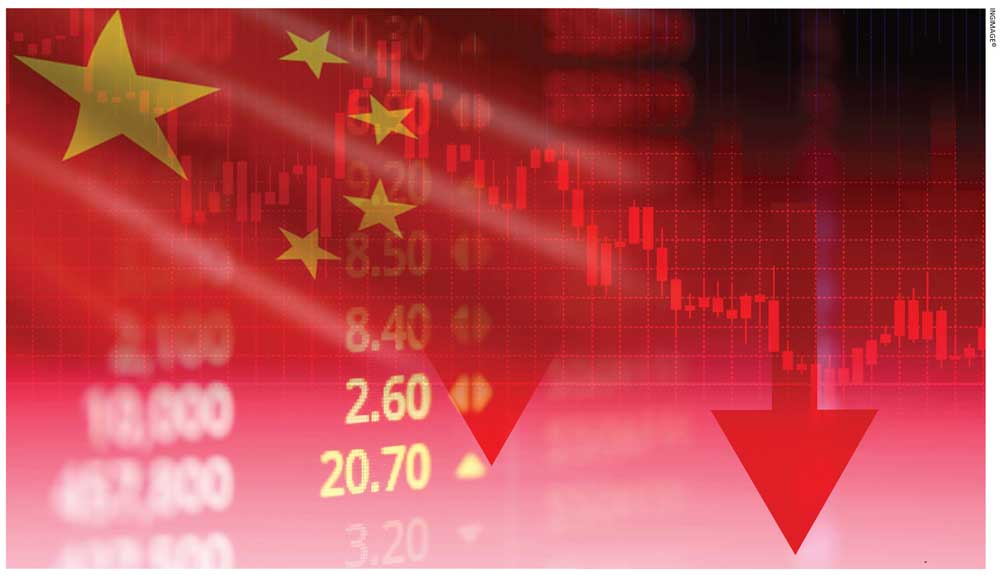CHINA ECONOMIC OUTLOOK

NEW PRODUCTIVE FORCES
Samantha Amerasinghe reports on China’s economic strategy and outlook

The National People’s Congress (NPC) held in March in Beijing surprisingly signalled more continuity than change. With its US$ 18 trillion economy facing serious headwinds and low confidence in present prospects, investors were closely watching the NPC for strategic direction on reforms and foreign policy, which may help shore up confidence in China.
China’s economy is grappling with multiple challenges including a property crisis, slowing exports, geopolitical tensions with the US, a population decline, huge debt and record youth unemployment.
So will President Xi Jinping’s ‘new productive forces’ be a key driver of the next phase in China’s development?
At the meeting, a fairly cautious GDP growth target of around five percent was set for 2024. However, this is considered somewhat ambitious by many domestic and international observers.
Though the Chinese government didn’t elaborate on how this target will be achieved, it is indicative of China’s leadership’s confidence in the future. It’s lower than the 5.2 percent growth achieved last year but higher than the IMF’s forecast of 4.6 percent.
Given that none of the customary economic drivers spurring China’s rapid economic growth over the past four decades – i.e. cheap labour, infrastructure investments, exports and foreign direct investments – are working effectively, this target seems out of reach unless there’s a shift in foreign policy.
Declining Western investment and business confidence in China have been of concern to Beijing. Uncertainty surrounding the country’s economy and intensified geopolitical tensions drove foreign investment out of China with international investors pulling out at a record rate.
Since 68.7 billion dollars’ worth of corporate and household capital flowed out of the country last year, it is clear that major changes in foreign policy are needed. Opening new areas of the Chinese economy to foreign investment with fewer restrictions will be the key, as well as strengthening intellectual property protection in China.
However, investment from the West is likely to continue to fall as countries look to de-risk their supply chains.
Emerging and developing nations will become increasingly important for trade. According to a recent NPC report, 46 percent of China’s trade in 2023 was with Belt and Road Initiative (BRI) member countries.
Although Beijing recognises the Global South as a key force for reforming the international order, its intention to join existing agreements such as the Digital Economy Partnership Agreement (DEPA) and Comprehensive and Progressive Agreement for Trans-Pacific Partnership (CPTPP) remains uncertain.
Members of these groups are growing increasingly concerned about China’s position on the rules-based international order.
Beijing is set to continue to pursue its BRI strategy but will focus on fewer large-scale infrastructure projects. The government’s key areas of interest will encompass digital, trade (including e-commerce), healthcare and green tech, and the promotion of and support for Chinese investments abroad.
Demand for Chinese goods overseas declined due to trade restrictions imposed by the US and EU, geopolitical concerns and shocks to global supply chains. A key message emphasised at the NPC was the need to strengthen the Chinese economy’s reliance on itself.
Xi spoke about the importance of fostering new productive forces, and alluded to technology and innovation being the emerging drivers of growth.
Science and technology innovation is a key priority as China faces heightened import restrictions by the US on technology and core components. Beijing’s science and technology budget is set to increase by 10 percent while support for basic research is expected to rise by 13.1 percent this year.
Chinese officials explicitly highlighted the need for the country to invent more products related to AI. Pursuing science and technological innovation cooperation with foreign counterparts was also deemed important through Chinese universities and tech businesses in areas such as joint artificial intelligence labs.
However, transforming the economy from one that is driven by investment and fuelled by debt, to one that’s driven by innovation and technology, will bring fresh challenges.
First, the private sector needs rapid growth, and innovation and risk taking have to be incentivised and rewarded.
Second, innovation requires more highly skilled human capital. Since China’s growth has so far been fuelled by low skilled labour, this poses a challenge.
And third, due to the energy intensive nature of high-tech industries such as AI, the country needs to diversify its energy supply.
On the foreign policy front, Beijing asserted that its strategic Sino-Russian relationship must be maintained despite the West’s continued criticism. China’s Foreign Minister Wang Yi was critical of the US and its obsession with suppressing China vis-à-vis double standards that are designed to protect American interests.
It is still too early to say whether Xi’s reforms will be the silver bullet for the Chinese economy. The so-called ‘third plenum’ of the Chinese Communist Party’s Central Committee, which is expected soon, might shed more light on China’s future strategy.






Leave a comment